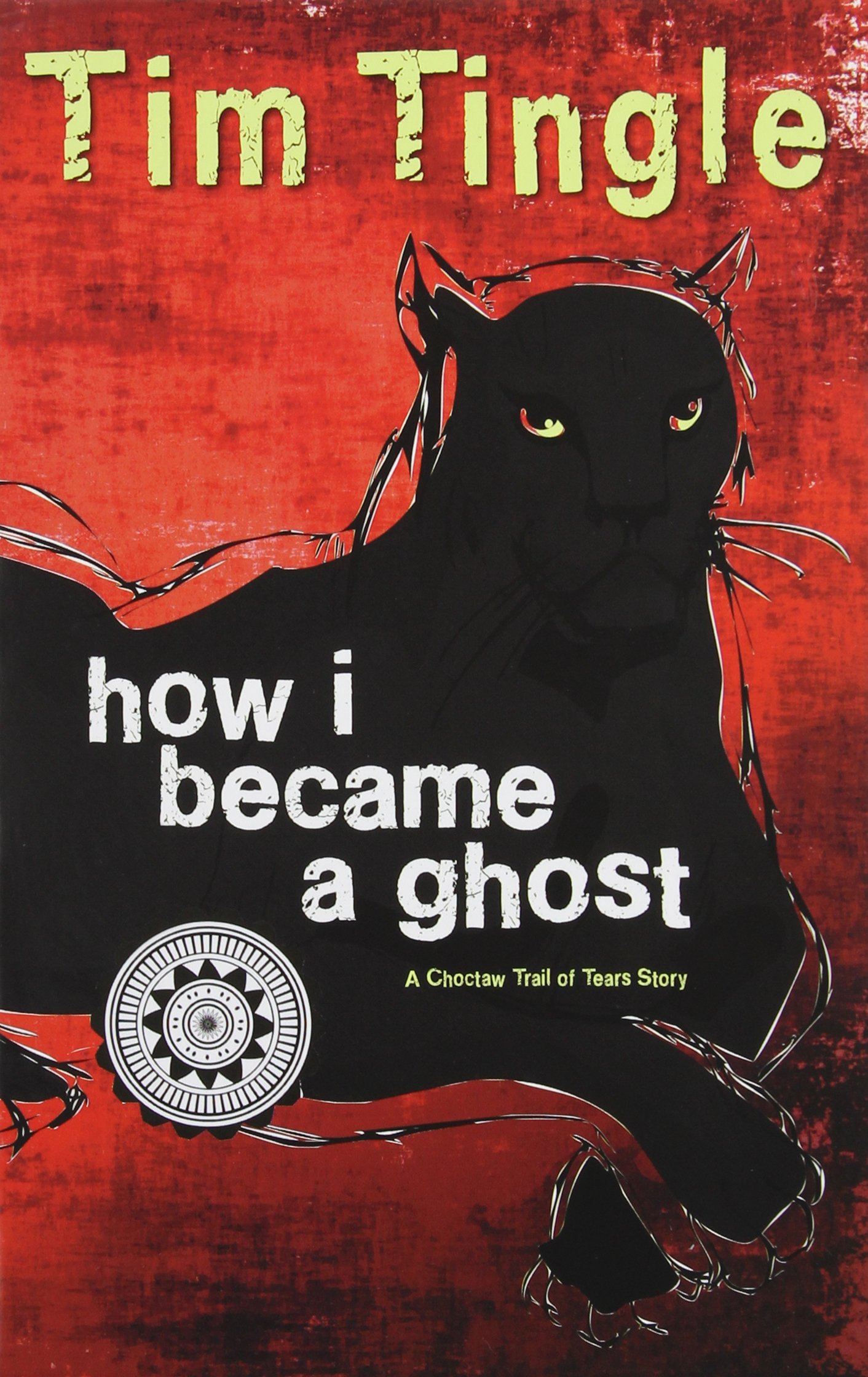
how i became a ghost: A Choctaw Trail of Tears Story
Written by Tim Tingle
The Roadrunner Press, 2013, 141pp.
ISBN 978-1937054557
Powerful reds and blacks and the mesmerizing eyes of the panther on the book cover pulled me in and dared me to pick up how i became a ghost: A Choctaw Trail of Tears Story. The panther has an outline drawn around him, which gives the appearance that he may move or pounce at any time. After watching the panther and feeling this fear, I noticed his regal posture and felt his leadership. I wanted to find out what was happening within the covers of this book.
Tim Tingle offers an emic approach to his studies of the Choctaw culture and heritage through his books. We learn that “his great-great-grandfather, John Carnes, actually walked the Trail of Tears in 1835.” Tingle has dedicated his life to educating people about the Choctaw culture and heritage; from his author website we learn that he has many impressive accomplishments towards this goal. He is an author, speaker, storyteller, winner of many state and national awards for his children’s and young adult literature books. He has spoken at the Library of Congress and performed at the Kennedy Center. I was surprised to learn that someone can hire him to come to his or her classroom and teach a workshop on storytelling or writing at a beginning to experienced level. In his academic pursuits, he has earned a Master’s Degree in English Literature at the University of Oklahoma in 2003.
Tingle has done a thorough job of recording and researching Choctaw history when he wrote this novel. This suspenseful story, described as historical fiction, travels along the Trail of Tears in 1835. We meet Isaac’s family: Mom, Dad, Luke, and Jumper. Isaac is a 10-year-old boy. We watch as soldiers burn their village. Many Choctaw are killed even before they start their walk to their new home. Some are burned or shot; most are killed from blankets infected with small pox.
Isaac’s mother invites us to watch a group of the oldest men say good-bye in their unique way in the woods. She says, “These men are saying good-bye to their home” (p.8). Next, his Mother leads Isaac to the river to watch the old women say good-bye to their homes. Both of these activities caused significant physical harm to their bodies, but all remain stoic. The Choctaw see their homes within nature, not the house they sleep in. As Bradford (2011) explains, there are “serious dangers in applying Western theoretical paradigms to non-Western texts” (p.334). This way of saying good-bye is significant enough for Isaac’s mother to make it a priority for her to teach Isaac.
A significant portion of this book discusses constant activity between the living world and the ghost world. Isaac shares, “I saw the Choctaw walkers, like before. But now I saw hundreds more Choctaws – Choctaw ghost walkers” (p. 43). Now they travel with their people as ghost walkers. Some Choctaw can see them but most cannot. Later this idea of living world and ghost world living together is strengthened, “No Choctaw would scream to drive a ghost away” (p.92).
Another window into Choctaw cultural experiences is that some Choctaw have the gift to turn into a panther. They are referred to as panther people. Most Choctaw have heard the stories but few have seen this transformation. In this book, one of the ghosts and the panther work together in a rescue mission. A door opened when I read “We did more than save Naomi today. We made our people proud. This is the highest honor a Choctaw can ever earn, to make the ancestors proud” (p.115). This statement reflects a strong and proud culture with a future strengthened by its people making honorable choices.
As a teaching tool, students can research the Trail of Tears and read for the significance of the line “Treaty Talk always meant something else, and that something else was never nice” (p.3). For additional pairings readers could also read about other American Indian tribes in Thirteen Moons on Turtle’s Back: A Native American Year of Moon (1992) by Josephy Bruchac and Jonathan London.
Jeanmarie Ford Bryant, University of Texas, Arlington
References
Bradford, Clare (2011). Teaching indigeneity: The ethics of interpretation and representation. In S. Wolf, K. Coats, P. Encisco, and C. Jenkins, (Eds.). Handbook of Research on Children’s and Young Adult Literature (p. 132-144). New York: Routledge.
Tingle, Tim (2017). Tim Tingle Choctaw Author, Speaker, Storyteller.
http://www.timtingle.com/tingle-s-bio.html
WOW Review, Volume XI, Issue 1 by Worlds of Words is licensed under a Creative Commons Attribution-NonCommercial-ShareAlike 4.0 International License.
Based on a work at http://wowlit.org/volume-xi-issue-1/
